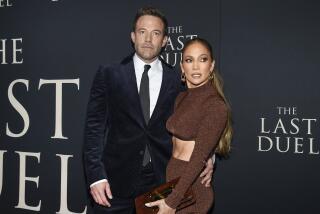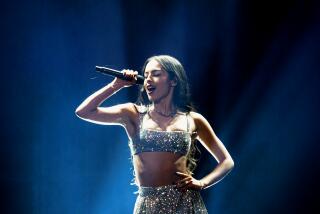What’s behind the dearth of female ‘American Idol’ finalists?
Blame the teenyboppers! “American Idol,” everyone agrees, has gone to the dollies.
Young women have long been held accountable for pop’s occasional loss of reason, from the bobby sox brigade that first embraced Frank Swoonatra to the hordes afflicted with Bieber Fever. Now this perennial crisis has overtaken “Idol.”
With only two women remaining in the finalists’ pool, critics, fans and even executive producer Ken Warwick have called for a halt to the reign of fast-voting misses and mums, which has thrown the game in favor of anything in three-day stubble.
Female voters do play a major role in the “Idol” outcome. But guess what? A decade’s worth of RIAA statistics prove that women buy as much music as men. They’re largely responsible for the stardom of Taylor Swift, Susan Boyle and Nicki Minaj, so to say they only vote with their (heterosexual) libidos is to grossly misjudge what women want.
And if you think girls only like fluffy mainstream hits, ask Arcade Fire, standard-bearers for equal-opportunity indie rock, or Jack White, who’s structured his entire career around partnerships with women like Meg White and Alison Mosshart.
Women care as much about the new Lady Gaga video, debuting on “Idol” this week, as they do about cuddly heartthrobs like Casey Abrams. The show regularly features the likes of Katy Perry and Gwen Stefani, who’ve contributed to the mash-up of empowerment and allure that characterizes the “post-feminist” pop star.
Just look to the judges’ table, in fact, and you’ll see the face of one such artist: Jennifer Lopez. Though sometimes derided during the height of her fame for not being a powerhouse singer, Lopez was a major player in redefining what a diva is now: not necessarily an octave-scaling knockout like Pia Toscano, but a multifaceted dancer/actress/vocalist/style icon.
“Idol” can’t turn out a top woman not because its voting constituency is boy crazy, but because its own musical framework is sadly irrelevant when it comes to what female pop stars do in the 21st century.
The occasional undeniable diva breaks through — Adele, an inspiration to embattled “Idol” survivor Haley Reinhart, is one example, and another is Carrie Underwood, the best inspiration for the other woman left standing, Lauren Alaina. For the most part, though, to make it in the pop world now a woman must do more than just stand there and show off a buxom instrument.
First and foremost, she should know how to move. Dance skills matter as much as big lungs in today’s very visual pop marketplace. Lopez, let’s remember, started her career as a member of the Fly Girls, the troupe that helped bring hip-hop moves to television on the comedy show “In Living Color.” For many of today’s major talents — Beyoncé, for example — singing and dancing are inseparable parts of a total package.
Naima Adedapo offered a glimpse of what an Idol rocking moves might look like, though her style often seemed more suitable for a Coachella tent than an arena stage. Her rivals don’t do much than teeter around on their high heels.
Women also do well in pop now by expanding the definition of what it means to be a good singer. Taylor Swift can’t sing well in the old-fashioned sense, but her highly conversational style welcomes girls into her world.
Today’s post-divas also explore multiple identities through performance. Less than a decade ago, Ashlee Simpson earned mass scorn when she lip-synced on “Saturday Night Live”; Perry did the same on “Idol” last week, but hardly a peep was raised, mostly because her David Bowie-esque staging was more interesting than the question of whether she hit her notes.
“Idol” doesn’t really give its hopefuls a chance to try any of this. Singing cover songs with the kind of band Whitney Houston would take on tour, on a set lifted out of a Vegas casino, these strivers can only reach back to styles that predate our much more high concept moment.
And here’s the rub: The stars now most successfully maintaining the traditional values “Idol” promotes are men. They live on in classic rock, pop metal, country, R&B, and the kind of jazzy singer-songwriter stuff Jason Mraz does.
Those are exactly the styles this year’s top male Idols mine so effectively. Some, like country sweetie Scotty McCreery and rocker James Durbin, appeal to loyalists within particular camps. Casey Abrams is more eclectic, but he gains credibility because the judges keep promoting him as a great instrumentalist — a role still mostly claimed by men, despite notable exceptions like Esperanza Spalding.
Even the one role it seemed a woman would always claim on “Idol” now belongs to a man: Jacob Lusk. Labeled a “diva” by virtually every critic out there, the gospel-grounded Lusk continues his fascinating tightrope walk between androgynous and chaste, transcendent and just plain over-the-top.
Lusk is this season’s real Toscano, the undeniable voice holding on within this popularity contest by continually knocking notes out of the park. Should we be surprised that even in this female-dominated role, a man has found a stronger foothold? I think not. Look at R. Kelly; consider Chris Brown. Even when it comes to divas, it seems that men are the ones now more enabled to survive.
More to Read
The biggest entertainment stories
Get our big stories about Hollywood, film, television, music, arts, culture and more right in your inbox as soon as they publish.
You may occasionally receive promotional content from the Los Angeles Times.










